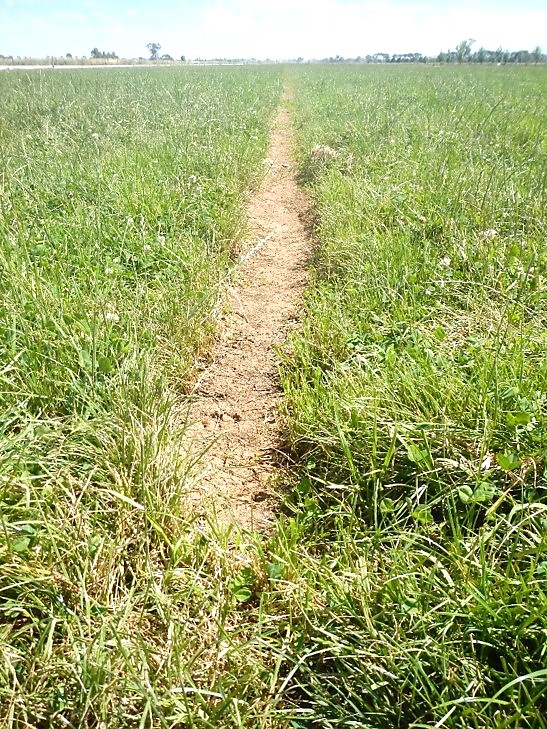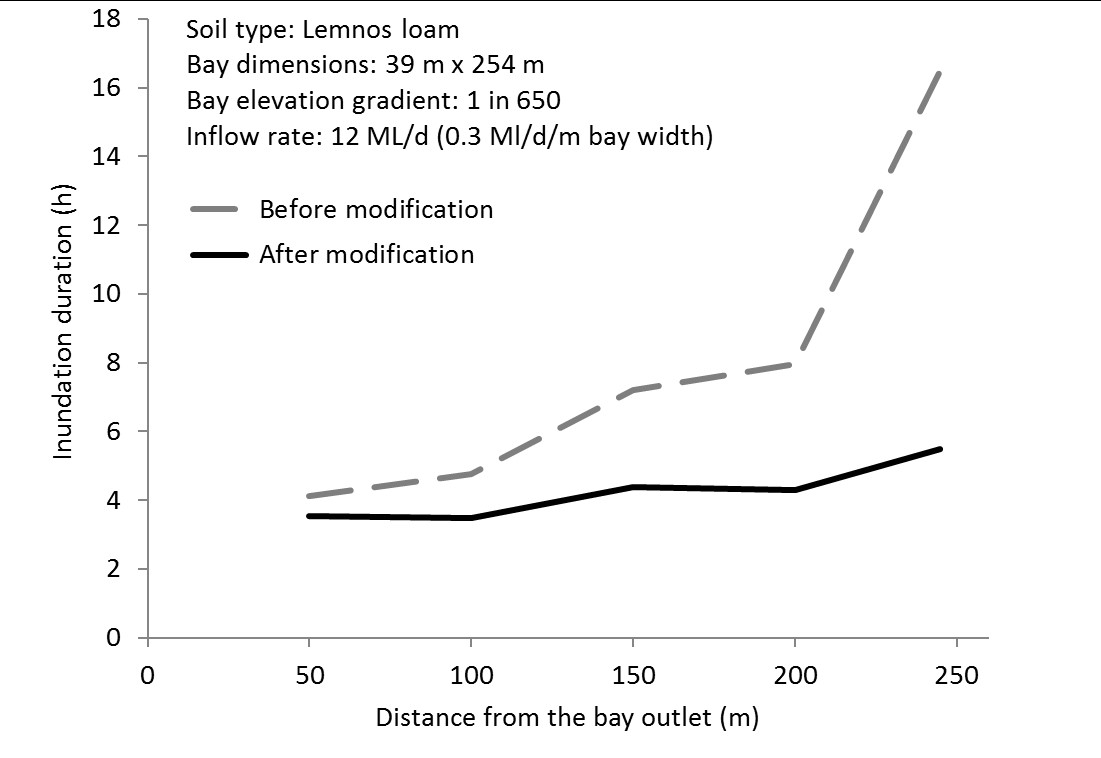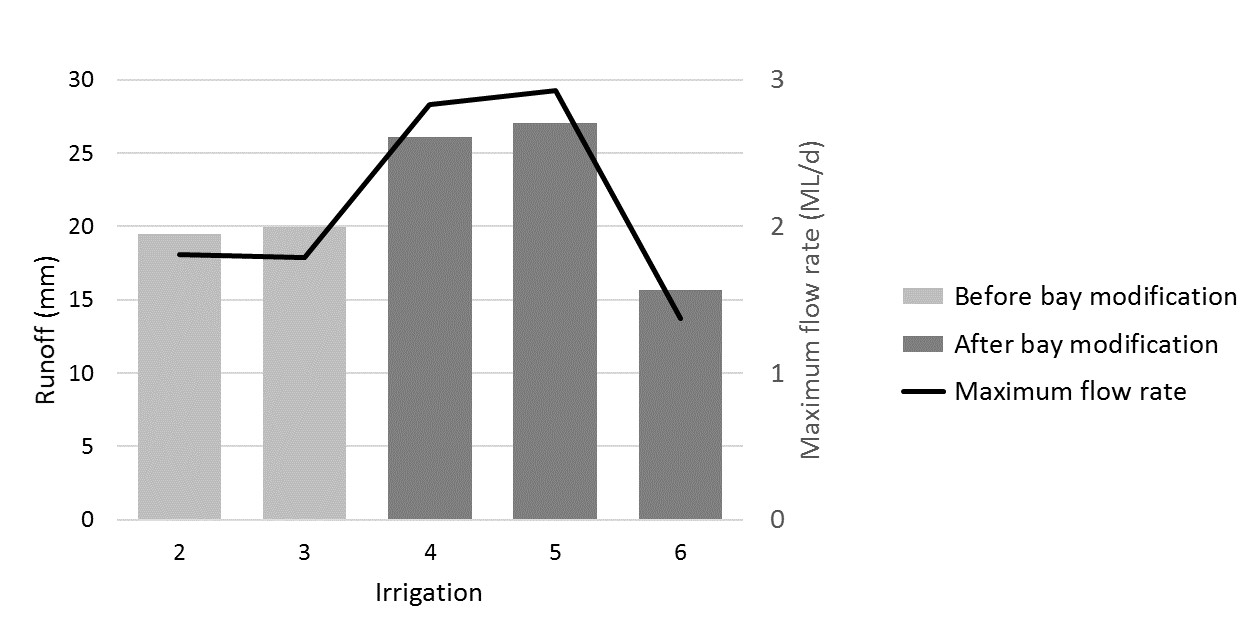Recent advances in border-check bay design
Author: Mike Morris, Amjed Hussain and Faith Githui (Agriculture Victoria Research, Tatura) | Date: 26 Jul 2018
Take home messages
- Surface drainage from conventional border-check bays on low infiltration soils is slow and causes non-uniform irrigations.
- Installing shallow surface drains on bay surfaces provides rapid surface drainage and more uniform irrigations better suited to precise irrigation scheduling.
- Modified bays require high standard surface drainage and reuse systems.
Background
Border-check is a very common irrigation practice. It is relatively inexpensive to set up and to operate, which is why over 90% of irrigated dairy farms in the southern Murray-Darling Basin use border-check systems (Ashton and Oliver, 2014). It is commonly used on sites that have elevation gradients of less than 1 in 300 and soil profiles that have relatively low permeability.
With billions of dollars spent modernising irrigation delivery systems in south-eastern Australia, it is now possible to supply water to plants at short notice and at known flow rates, enabling more precise irrigation scheduling. Irrigation automation and a growing range of soil moisture, remote sensing and cloud based scheduling tools can take the effort and guesswork out of precise scheduling. Now the limitation to precise scheduling can be the precision of the bay itself.
The precision of bay problem arises on low permeability soils because the drainage of excess surface water from bays is very much slower that the process of applying the water. Excess surface water at the top of bays must find its way to the drain by flowing across the entire downslope surface of the bay. With modernised systems, applying irrigation water can be relatively quick, but once the supply is cut off, system energy rapidly dissipates. This leaves the excess surface water slowly finding its way down the length of bays in a process that can take days to complete, leading to non-uniform irrigations and deep drainage losses.
Method
To address this problem, the ANUGA inundation model for use as a two-dimensional surface irrigation model was adapted. ANUGA was developed by the Australian National University and Geosciences Australia to study the impacts of tsunamis striking coastlines and has since been used in a variety of applications. Our adaptation of ANUGA included code to simulate infiltration (Githui et al, 2015) and code to track and summarise the duration of inundation across a simulated bay surface. The use of ANUGA for simulation of border-check irrigations was validated (Morris et al, 2015) and then the model was used to compare potential bay surface modifications under a wide range of bay dimensions and slopes, inflow rates, soil types and crops.
A bay surface modification that reduced both the duration of inundation and the variation in duration of inundation was found and then compared with the performance of conventional and modified bays over an irrigation season at two sites in Victoria.
Results and discussion
Simulations
The bay surface that substantially reduced both the duration and variation of inundation across all conditions proved to be a simple modification that has been used on a few dairy farms in northern Victoria for more than a decade. It consists of very shallow surface drains that run parallel to the check-banks (Figure 1).

Figure 1. Shallow drain installed in a perennial pasture bay.
The drains are installed only a few centimetres deep. The two outer drains are spaced 7m in from each check-bank with the remaining drains evenly spaced 10m to 15m apart, starting roughly 15m from the top of the bay and extending to the paddock drain at the foot of the bay. Advantages of this bay surface over all the others that were simulated include:
- Robustness – the simulated design performed well over a wide range of bay dimensions and slopes, soils and crops.
- Simplicity – it can be installed using simple and accessible technology.
- Cost-effectiveness – it is relatively cheap to install with no disruption to production.
- Implementation can be staged.
Field measurements
In the past few years detailed measurements to compare irrigations on modified and conventional bays at three sites have been taken (Table 1).
Table 1. Characteristics of measurement field sites.
Site | Soil | Crop | Bay length | Bay width | Bay gradient | Inflow rate |
|---|---|---|---|---|---|---|
1 | Lemnos loam | Perennial pasture | 254 | 39 | 1:650 | 0.31 |
2 | Wanalta loam | Sorghum | 342 | 58 | 1:770 | 0.20 |
3 | Wooundellah loam | Perennial pasture | 213 | 53 | 1:550 | 0.17 - 0.25 |
For brevity, this paper will focus on results from Site 1, as Both Site 2 and Site 3 produced results consistent with results from Site 1.
Inundation duration
At Site 1, three irrigations were measured on a conventional bay before the installation of shallow drains, with a further three irrigations measured after installation. Figure 2 shows the effect of the bay modification on the duration of inundation. Only once the shallow drains have been installed does the entire bay get a very similar irrigation with minimal time for deep drainage losses.
Irrigation runoff
The shallow surface drains increase both the total volume of runoff and the peak runoff flow rate and for this reason efficient surface drainage and re-use systems are needed. Figure 3 provides an indication of the increase in runoff volume and flow rate experienced with installation of the shallow drains at Site 1. Runoff volume was 20mm with a maximum flow rate of 1.8ML/d prior to installation of the surface drains, increasing to approximately 27mm and a maximum flow rate of 2.9ML/d after installation. At Irrigation 6 the farmer reduced the volume of inflow and achieved a full irrigation while reducing runoff to 16mm with a maximum flow rate of 1.4ML/d.

Figure 2. Effect of surface drains on inundation duration at Site 1.

Figure 3. Site 1 runoff before and after installation of surface drains.
Costs
An analysis of modified bay surface installation and maintenance costs has been prepared based on the management practices of a dairy industry irrigator who has been using the bay modification for several years. His current practice on dairy pastures is to regularly clean the shallow drains with a rotary digger after every second grazing, taking care to not deepen the drains. Estimated cost to install the drains was $29/ha, with ongoing maintenance of $71/ha each year.
Implications
If irrigation runoff is efficiently captured and reused, the modified bay surface provides efficient and uniform irrigations across an entire bay, meaning that the entire crop gets the same irrigation with minimal deep drainage losses. This makes feasible precision scheduling of automated border-check irrigations.
A more efficient bay surface may also allow for the relaxation of conventional bay design guidelines with respect to maximum bay dimensions and minimum bay slopes.
Next steps
It is yet to be demonstrated; best practice border-check surface irrigation as a package using
- The modified bay surface for irrigation uniformity
- automated irrigation scheduling with forecasting and
- integrated automation of irrigations and reuse systems.
The modified bay surface can provide uniform irrigations across an entire bay, enabling precise, automated scheduling of irrigations for the entire bay. Automated scheduling with forecasting has the potential for substantial improvements in water productivity and the reduction of off-site impacts caused by irrigation, while integrating automation of irrigations and reuse systems enables optimal farm surface water management with labour and water savings. Putting all this together and demonstrating it as a package is a logical next step.
Conclusion
Shallow surface drains that cut into the surface of border-check bays can substantially improve irrigation efficiency and uniformity, if surface runoff is efficiently reused. The modified bay surface enables the effective implementation of precise scheduling of automated irrigations and can allow relaxation of current conventional border-check bay design guidelines relating to bay dimensions and slope.
Useful resources
A fact sheet and technical note on this work have been prepared, and a YouTube video is undergoing final edits. These will be available on the Agriculture Victoria website in the next few months. In the meantime, please contact the author for a copy of these resources.
References
Ashton, D. and Oliver, M. 2014. Irrigation technology and water use on farms in the Murray–Darling Basin, 2006–07 to 2011–12. ABARES Research Report 14.3
Githui F., Hussain A. Morris M. (2015). Adapting ANUGA model for border-check irrigation simulation. MODSIM2015 International Congress on Modelling and Simulation.
Morris M., Githui F., Hussain A. (2015). Application of ANUGA as a 2D surface irrigation model. MODSIM2015 International Congress on Modelling and Simulation.
Acknowledgements
This research was made possible by the significant contributions of the dairy farmers who have hosted and assisted us on our field sites. The work has been resourced by Dairy Australia, the Commonwealth Department of Agriculture and Water Resources Rural R&D for Profit Programme and the Victorian Department of Economic Development, Jobs, Transport and Resources.
Contact details
Mike Morris
Agriculture Victoria Research, 255 Ferguson Road, Tatura 3616.
0358 242280
mike.morris@ecodev.vic.gov.au
Was this page helpful?
YOUR FEEDBACK
